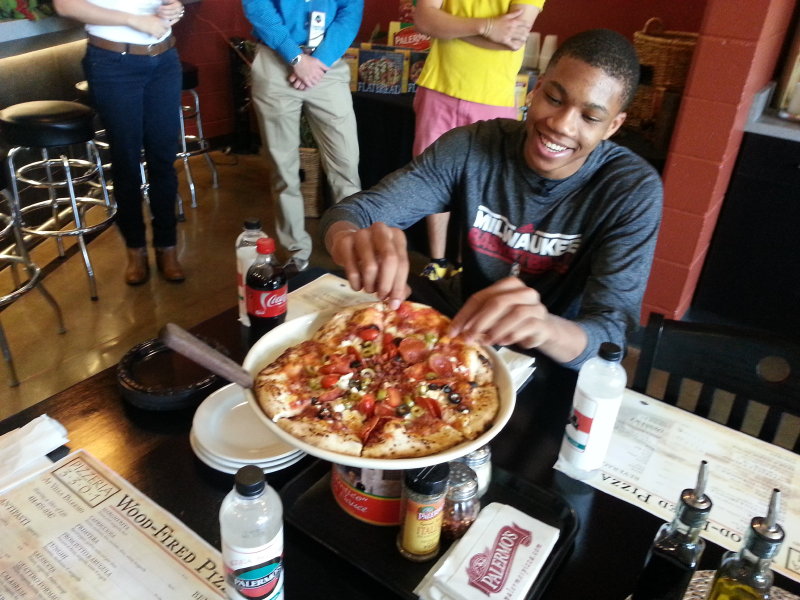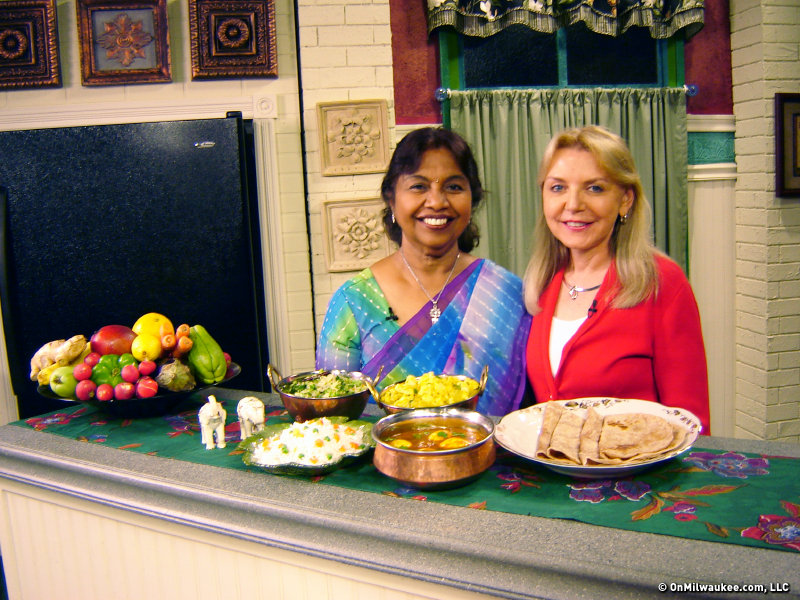Welcome to Healthy Living Week at OnMilwaukee.com! The resolutions are made, now the real work begins. But we're here to help get you – and keep you – on track with stories about medicine, diet, exercise, spiritual and emotional health, and more. Healthy Living Week is brought to you by Pairdd: easy gluten-free cooking at your fingertips.
In the 1990s, Tony Smith would cruise around Los Angeles looking for one thing – a Fatburger.
The Wauwatosa native joined the L.A. Lakers at the tail end of the Showtime era and played in an NBA Finals his rookie year in 1991 alongside Hall of Famers Earvin "Magic" Johnson and James Worthy and quality role players like Byron Scott and A.C. Green who had long careers.
But, Smith was young, fresh out of Marquette University and that fast food was the way to go.
"Man, I was fast food all day long," chuckled Smith, now a Milwaukee Bucks pre and post-game host for Fox Sports Wisconsin. "Fatburger. Fatburger was my favorite – post game meal, though. Not pregame. I knew enough from college to eat some spaghetti or pasta. Every now and then I’d try to eat healthy but for the most part I was not watching my diet at all."
Caron Butler entered the league two years after Smith retired, joining the Miami Heat as a 22-year-old in 2002-03 out of the University of Connecticut.
There were veterans on that team, guys with eight years of service or more like Eddie Jones, Brian Grant and LaPhonso Ellis. He then spent a year in Los Angeles as well, alongside one of Smith’s former teammates in 15-year vet Vlade Divac.
Then, at the age of 25, while in Washington, Butler noticed a change. But not a good one.
"I was in a bad place – like man, I’m feeling sluggish, I’m feeling like I’m working a little bit too hard to do what I have to do," Butler said.
Mountain Dew was a staple in his daily diet. A big staple. He quit that cold turkey and re-evaluated what he was eating. He hired a personal chef to cook healthier, more balanced meals. He dropped nearly 15 pounds and, not coincidentally, put together the three best seasons of his NBA career.
In the three NBA seasons that stretched across 2006 to 2009, Butler made two All-Star games and averaged 20.1 points, 6.8 rebounds and 4.3 assists per game.
"It’s a great investment," Butler said of the chef. "Some guys buy jewelry and other things. Some guys choose to invest in their body and in to their craft so they can continue to make this living. I think that’s the biggest and ultimate investment is taking care of your temple and making sure that you’re right and thinking years and years beyond. I did that. I seen guys before me do it and I see a lot more younger guys doing it."
Without hesitation, he said he would not still be in the league at the age of 33 without making that change.
In his playing days, Smith did get some healthy cooking from an aunt that moved out to Los Angeles with him, but for the most part players were left to their own devices when it came to diet – unless their weight really ballooned or were having health issues. That’s when the team would step in to help.
"Back when I was playing it wasn’t even a thought," Smith said about eating healthy. "It just wasn’t something that was in the mass media. Now, everything is out there, on TV, on the internet. Back in the day that stuff wasn’t big either. Information wasn’t as readily (available) as it is now.
"All that stuff is new, man, to a certain degree. Some people have had knowledge of it on their own, but as far as it being readily available for everybody, everywhere, that’s really new."
Robert Hackett, the first-year head strength and conditioning coach for the Milwaukee Bucks, agreed.
Hackett, a Milwaukee native, has spent two decades working in the NBA after graduating from the University of Wisconsin. He won a championship with the Dallas Mavericks in 2011 said that over the course of his time in the NBA, players have become more educated about what to put in their body, and that teams take more a proactive effort in adding to that knowledge.
"It’s just become more open and educational towards the players," Hackett said. "And also bringing in nutritionists and having players sit down and talk with them. Usually it was only with players who had problems, but now you do it with everyone, and talk about their diet. The conditioning and staying in shape and working out, they get that because of the nature of the sport and how the grind is in the NBA, but then to bring in the nutritional standpoint and talk about eating better to help them perform better."
While not every player in the NBA has the means to hire his own personal chef, the team does provide one that will make about 10 meals per week for any player who needs it. There is a cost involved, but it is far cheaper per day than going out to a restaurant, and far healthier than hitting the various fast food locations around the city.
This has been an important development in the NBA, especially for young players who don’t come into the league with certain financial means or knowledge. They certainly didn’t know how to cook. And being broke and in college, or coming out of high school, all those guys knew was cheap, fast food. Now, teams help take that out of the equation.
"Now they have a choice," Hackett said. "Now you have to have more balanced meals and a lot of these young guys, especially if they’re single, we introduce chefs to them so somebody can prepare their meals and not only that you’re eating god but that they’re nutritional and healthy value meals instead of just eating whatever."
Hackett said in the past, the truly great athletes and those that played for a long time eventually figured out that eating healthy and getting enough sleep were keys to such success, but it was usually passed down from generation to generation by the players themselves. Some players bought in to it, some didn’t.
In L.A., Smith remembered Scott working long hours on his body and making sure he put the right food into it.
"When I came into the league he was always in the weight room working out and was saying ‘You’ll wish you look this good when you get to 30-something’ and I’m just laughing at him like ‘Quiet old man’ but he did take care of himself," Smith laughed. "He was in great shape at 30-plus something. He was definitely a guy I knew who definitely took care of his body. At that time I didn’t understand what he was doing, but I knew he was doing something."
The same could be said for Butler’s early years, but he sees young players come into the league having an understanding about their diet he didn’t.
"A lot of guys are doing a better job of watching their intake and what they’re putting in their body," he said. "They’re eating things that give them a lot of energy. Before, when we came in, it was a lot of fast food and trying to perform at a premium level. You are what you eat. At some point you run out of gas and I think guys do a better job of taking care of their temple."
"Everyone is more aware of it," Hackett said of healthy living in the NBA. "But the guys really understand the importance of prolonging their career and eating better and getting enough rest and taking care of themselves. Their body is their means to their income."
Jim Owczarski is an award-winning sports journalist and comes to Milwaukee by way of the Chicago Sun-Times Media Network.
A three-year Wisconsin resident who has considered Milwaukee a second home for the better part of seven years, he brings to the market experience covering nearly all major and college sports.
To this point in his career, he has been awarded six national Associated Press Sports Editors awards for investigative reporting, feature writing, breaking news and projects. He is also a four-time nominee for the prestigious Peter J. Lisagor Awards for Exemplary Journalism, presented by the Chicago Headline Club, and is a two-time winner for Best Sports Story. He has also won numerous other Illinois Press Association, Illinois Associated Press and Northern Illinois Newspaper Association awards.
Jim's career started in earnest as a North Central College (Naperville, Ill.) senior in 2002 when he received a Richter Fellowship to cover the Chicago White Sox in spring training. He was hired by the Naperville Sun in 2003 and moved on to the Aurora Beacon News in 2007 before joining OnMilwaukee.com.
In that time, he has covered the events, news and personalities that make up the PGA Tour, LPGA Tour, Major League Baseball, the National Football League, the National Hockey League, NCAA football, baseball and men's and women's basketball as well as boxing, mixed martial arts and various U.S. Olympic teams.
Golf aficionados who venture into Illinois have also read Jim in GOLF Chicago Magazine as well as the Chicago District Golfer and Illinois Golfer magazines.







